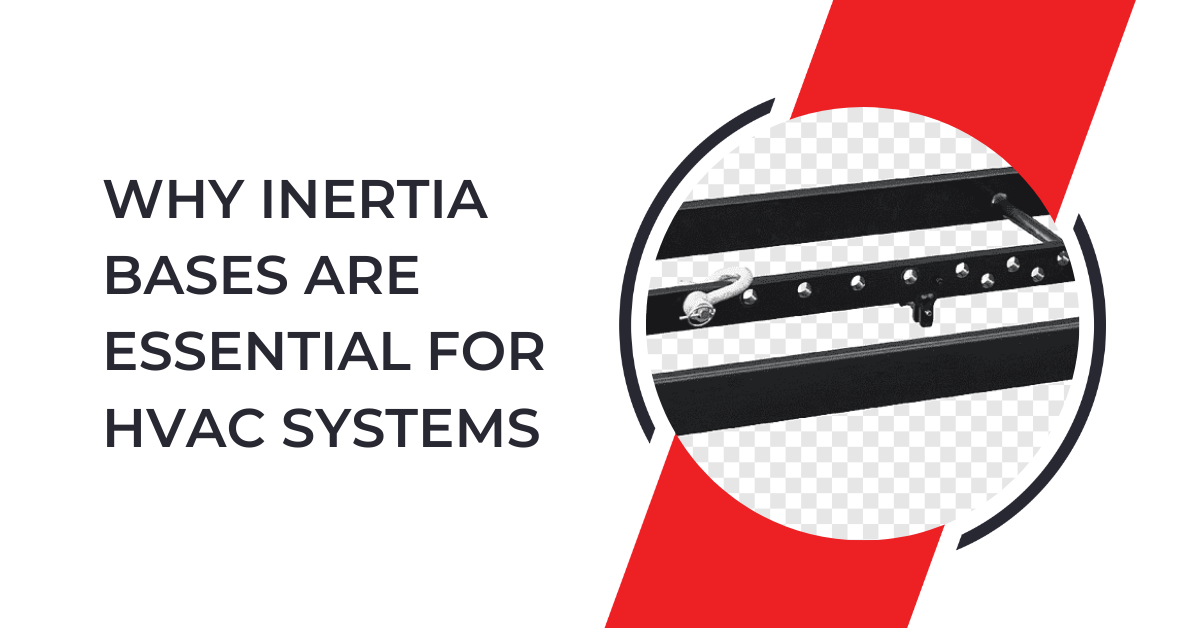When it comes to ensuring HVAC (Heating, Ventilation, and Air Conditioning) systems work efficiently, inertia bases play a critical role. Although HVAC systems are essential for comfort and air quality, they can create vibrations that affect both the equipment and the surrounding structure. Inertia bases are designed to reduce these vibrations, making HVAC systems quieter, safer, and longer-lasting. This blog will break down the importance of inertia bases for HVAC systems, highlighting why they are a valuable addition to any building.
What Are Inertia Bases?
Inertia bases are specially designed structures, often made from steel frames and concrete, that sit beneath HVAC equipment. Their primary function is to absorb vibrations, acting as a solid foundation for heavy HVAC units. These bases help control vibration and noise, which is especially important in commercial and residential buildings where quiet and stability are needed.
Inertia bases are engineered to balance and stabilize the equipment, preventing unwanted movements that can happen due to the operation of the HVAC system. In essence, inertia bases serve as the support system that keeps HVAC units running smoothly without affecting the surrounding environment.
Note – Experience optimal performance and perfect acoustics with Inertia Bases tailored for stability and noise control. Enhance HVAC efficiency, protect your building, and create a quieter environment with expertly designed inertia bases. Get started today to elevate your space’s comfort and durability!
How Do Inertia Bases Work?
Inertia bases function by adding weight and stability to HVAC equipment. They typically consist of a steel frame filled with concrete, which provides a firm, heavy foundation. When an HVAC unit operates, it generates energy that can lead to vibrations. These vibrations can pass through the floor and walls, causing noise and potentially damaging the structure over time.
The extra mass provided by inertia bases helps dampen these vibrations. When installed correctly, inertia bases act as a buffer between the HVAC unit and the floor. This buffering effect minimizes the amount of energy transferred to the building, making the unit quieter and reducing wear and tear on both the HVAC system and the building structure.

Key Benefits of Inertia Bases for HVAC Systems
Now that we understand the basic function of inertia bases, let’s explore the primary benefits they bring to HVAC systems. These advantages are the reasons why many HVAC professionals recommend installing inertia bases in various settings, from residential buildings to large industrial facilities.
1. Reduces Noise Levels
One of the main benefits of using inertia bases with HVAC systems is noise reduction. HVAC systems can be quite loud, especially larger commercial units. The vibrations from the equipment often generate noise that can be disturbing, especially in buildings where quiet environments are necessary, like hospitals, libraries, or offices.
By absorbing and dampening these vibrations, inertia bases significantly reduce the noise produced by HVAC systems. This makes the environment more comfortable for occupants, allowing people to work, rest, or enjoy quiet spaces without the disruption of constant HVAC noise.
2. Protects Building Structure
Vibrations from HVAC equipment don’t just create noise—they can also lead to structural damage over time. Continuous vibrations can weaken the floors, walls, and ceilings around the HVAC system. In severe cases, this may result in cracks, loose fittings, and other structural issues.
Inertia bases prevent this type of damage by absorbing and isolating vibrations, stopping them from being transferred to the building. By installing inertia bases, building owners can protect their structures and reduce the need for costly repairs.
3. Increases HVAC System Longevity
HVAC systems are expensive investments, and regular maintenance can add up over time. Inertia bases help reduce wear and tear on HVAC equipment by providing stability and minimizing vibrations. When the unit operates smoothly, with fewer vibrations, there is less stress on the various components within the HVAC system.
This reduction in stress can extend the lifespan of the equipment, allowing it to function effectively for a longer period. In the long run, inertia bases can lead to savings by reducing the frequency of repairs and replacement parts.
4. Improves Energy Efficiency
Efficiency is crucial for any HVAC system, and inertia bases play a role in enhancing it. When HVAC equipment operates with reduced vibrations, it doesn’t need to work as hard to achieve the same output. Unwanted movements and vibrations can cause an HVAC unit to consume more energy, as it needs extra power to stay stable.
By adding an inertia base, the system operates in a more stable environment, making it easier for the HVAC equipment to perform efficiently. This helps save on energy costs and makes the building more environmentally friendly by reducing overall energy consumption.
5. Enhances Safety in the Building
Safety is a top priority in any building, especially when it comes to large, powerful equipment like HVAC systems. An unstable HVAC unit can create hazards, not only by causing structural issues but also by posing a direct risk to anyone working nearby.
With an inertia base, the equipment becomes more secure and stable. There’s less chance of the unit moving or shifting, reducing the risk of accidents. This is particularly important in places like factories or facilities where employees work close to the HVAC system.
Why HVAC Systems Without Inertia Bases May Face Problems
While some HVAC systems operate without inertia bases, this can lead to several problems over time. Here’s why skipping inertia bases might not be the best choice:
1. Increased Maintenance Costs
Without an inertia base, HVAC systems are more susceptible to wear and tear. This often means higher maintenance costs, as the equipment may require frequent repairs or part replacements. Over time, these costs add up, making inertia bases a worthwhile investment.
2. Higher Noise Levels
HVAC systems without inertia bases can create louder environments, as there’s nothing to dampen the vibrations. This can be a disturbance for building occupants and may even impact the value of the property, as a noisy environment is less appealing.
3. Potential Structural Damage
As mentioned, continuous vibrations can weaken the structure around the HVAC system. Buildings that house large, heavy HVAC units without inertia bases may face higher risks of structural damage, leading to expensive repairs.
How to Choose the Right Inertia Base for Your HVAC System
Choosing the right inertia base is essential to get the most out of your HVAC system. Here are some factors to consider when selecting an inertia base:
1. Weight and Size of the HVAC Unit
The size and weight of the HVAC system will determine the type of inertia base needed. Heavier equipment will require a larger, more robust inertia base to provide adequate support.
2. Type of Building
The building type is important because some structures may require more vibration control than others. For instance, hospitals and schools prioritize quiet environments, so they may need more effective vibration-damping solutions.
3. Budget and Installation Requirements
Inertia bases come in various designs and price ranges. It’s essential to consider the budget and the installation process, as some bases are more complex to install than others. Consulting with an HVAC specialist can help identify the best inertia base that fits both your budget and the building’s requirements.
Conclusion: Inertia Bases Are Worth the Investment
Inertia bases are a valuable addition to any HVAC system, particularly in buildings where noise control, structural integrity, and energy efficiency are important. By reducing vibrations, inertia bases protect the HVAC equipment, enhance its efficiency, and make the surrounding environment more comfortable and safe.
In essence, inertia bases offer a range of benefits that contribute to the longevity and performance of HVAC systems. For building owners, investing in inertia bases can lead to long-term savings, fewer maintenance issues, and a better experience for everyone who uses the space. Whether for a small residential unit or a large commercial setup, inertia bases provide essential support that can make a significant difference in the performance and reliability of HVAC systems.
For more insightful articles related to this topic, feel free to visit travellblog.com




